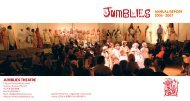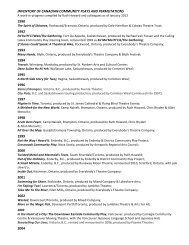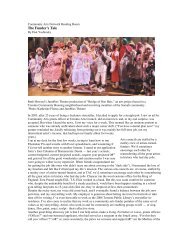publication - Jumblies Theatre
publication - Jumblies Theatre
publication - Jumblies Theatre
- No tags were found...
You also want an ePaper? Increase the reach of your titles
YUMPU automatically turns print PDFs into web optimized ePapers that Google loves.
according to Creative Class Group, Florida’s marketing think tank. 6 They are also “fickle” and “finicky”, saysFlorida, which is why “understanding the factors associated with why these creative types of people rootin a certain place is critical.” 7 The creative class are asking: “What kind of location offers me the bundleof lifestyle choices with the diversity of amenities and options that I desire?” 8While Florida has elaborated on his original ideas in multiple <strong>publication</strong>s since The Rise of the CreativeClass most proponents of the Creative City continue to derive a relatively simple hypothesis from his work.“[W]hat drives a city…increasingly are good places to live, great neighborhoods, great cafes, night life,places to have fun.” 9 Creative types are apparently drawn to Florida’s “Three Ts”, technology, talent andtolerance. 10 A city will appeal to creative professionals if it already has a strong creative sector, a base oftalented artists and innovators and room for diverse cultures and lifestyles.Creative City theory has been embraced by municipal, provincial and state governments across NorthAmerica for over to a decade now, fuelling countless reports and planning documents emphasizing“creative place-making”, “neighbourhood revitalization”, “culture-led regeneration”, “high profilecultural zones” and “authentic urban environments”. 11 In a bid to cater to the creative class, citieshave raced to implement Florida’s recommendations, paying five figure sums 12 to hire Creative ClassGroup as consultants. Toronto has been no exception. The Toronto Arts Council Foundation has hostedconferences such as Creative City: Block by Block (2007) and Art at the Hub (2008). 13 The City of Toronto’sCultural Services produced a Culture Plan for the Creative City in 2003, which argues that cities like Montreal,Chicago, Barcelona and Milan are now our chief competitors and that, in order to achieve economicsuccess, we must up our creative edge to draw “the kind of people Toronto wants to attract”. 14 The city’sCulture Plan has driven campaigns like Live With Culture, a sixteen month promotion of local cultural events,and bolstered support for new annual arts festivals like Luminato and Scotiabank Nuit Blanche. Toronto’sfocus on becoming a Creative City also led to financial support from multiple levels of government forredesigned cultural attractions like the ROM Crystal and the Four Seasons Centre for the PerformingArts. 15 In combination these developments have been touted as evidence of Toronto’s cultural renaissance.Proponents of this cultural renaissance often argue that we are poised to become a ‘world class city’ if wekeep doing things right.Culture + Place = Wealth? 16 33At first glance a movement that emphasizes urban diversity, the arts, and social innovation is veryappealing. What on earth could be wrong with investing in the arts? What is the difference between theplace-making advocated by Creative City enthusiasts and the place-making that community artists engagein? Like Florida and his followers, community artists are invested in creating “vibrant, authentic places”. 17We too believe that art is key to a city’s livability. Creative City theory even has the potential to paydividends in the form of increased arts funding. Why would artists want to oppose it?








